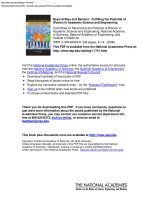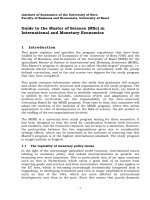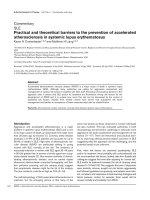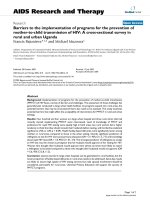Motives and barriers to the internationalization of smes case study of “nghia nippers corporation
Bạn đang xem bản rút gọn của tài liệu. Xem và tải ngay bản đầy đủ của tài liệu tại đây (4.21 MB, 114 trang )
MINISTRY OF EDUCATION AND TRAINING
UNIVERSITY OF ECONOMICS HO CHI MINH CITY
------------------------
NGUYEN THI HAI YEN
MOTIVES AND BARRIERS TO
THE INTERNATIONALIZATION OF SMES
CASE STUDY OF “NGHIA NIPPERS CORPORATION”
THESIS FOR MASTER OF EMBA
EXECUTIVE MASTER OF BUSINESS ADMINISTRATION
Ho Chi Minh City - 2017
MINISTRY OF EDUCATION AND TRAINING
UNIVERSITY OF ECONOMICS HO CHI MINH CITY
------------------------
NGUYEN THI HAI YEN
MOTIVES AND BARRIERS TO
THE INTERNATIONALIZATION OF SMES
CASE STUDY OF “NGHIA NIPPERS CORPORATION”
Major: Business Administration
(Executive MBA)
Code: 60340102
THESIS FOR MASTER OF EMBA
EXECUTIVE MASTER OF BUSINESS ADMINISTRATION
Academic Instructor: PR.DR HO DUC HUNG
Ho Chi Minh City - 2017
Statement of Authentication
I hereby declare that the work presented in this thesis is, to the best of my
knowledge and belief, original. The ideas and quotes taken from external sources
are duly acknowledged in the text. The material, either in full or in part, has not
been previously submited to any other institution.
Ho Chi Minh City, 2017
Nguyen Thi Hai Yen
Table of Contents
Statement of Authentication
List of Figures
List of Tables
Abstract .......................................................................................................................1
Chapter 1 Introduction ...............................................................................................2
1.1 Background of Research ..................................................................................3
1.2 Research purposes and research questions ......................................................5
1.3 Limitations and implications ............................................................................5
1.4 Outline of the thesis .........................................................................................7
Chapter 2 Theoretical Framework .............................................................................9
2.1 Definition of Internationalization.....................................................................9
2.2 Theories of Internationalization .......................................................................9
2.2.1
Economic approach of internationalization ....................................... 10
2.2.2
Behavioral approach of internationalization ..................................... 13
2.3 Latest internationalization approaches ...........................................................19
2.3.1
Born Global ....................................................................................... 19
2.3.2
Network theory .................................................................................. 21
2.4 Internationalization motives ...........................................................................23
2.5 Internationalization triggers ...........................................................................24
2.6 Internationalization barriers ...........................................................................28
2.7 Summary ........................................................................................................29
Chapter 3 Methodological part.................................................................................30
3.1 Definition of Methodology ............................................................................30
3.2 Choice of philosophical position....................................................................31
3.3 Formulating the research design ....................................................................32
3.4 Research strategy ...........................................................................................34
3.5 Data collection ...............................................................................................36
3.6 Data analysis ..................................................................................................39
3.7 Quality of the research issues.........................................................................41
3.8 Summary ........................................................................................................42
Chapter 4 Empirical part ..........................................................................................43
4.1 Presentation of the company “Nghia Nippers Corporation” .........................43
4.2 The results of the interviews ..........................................................................44
4.2.1
Characteristics of the firm ................................................................. 45
4.2.2
Characteristics of owner/manager of the company ........................... 47
4.2.3
Sources of information ...................................................................... 47
4.2.4
Entry mode and market selection ...................................................... 48
4.2.5
Company’s strategies ........................................................................ 48
4.2.6
Motives .............................................................................................. 49
4.2.7
Barriers .............................................................................................. 50
4.2.8
Advantages and Disadvantages of export activities .......................... 50
4.2.9
Future suggestions ............................................................................. 50
4.3 Empirical findings ..........................................................................................51
4.3.1
History of companies activities ......................................................... 52
4.3.2
Motives and barriers .......................................................................... 54
4.4 Summary ........................................................................................................54
Chapter 5 Analysis ....................................................................................................55
5.1 Internationalization process of “ Nghia Nippers Corporation” .....................55
5.2 Motives of the internationalization of Nghia Nippers Corp. .........................57
5.3 Internationalization barriers ...........................................................................58
5.4 Summary ........................................................................................................58
Chapter 6 Discussion and Conclusions ....................................................................59
6.1 Discussion ......................................................................................................59
6.2 Summary of the study ....................................................................................60
6.3 Suggestions for the future research ................................................................62
Bibliography
Appendix 1: Interview Guide
Appendix 2: The company logotype and Product Lists for export
Appendix 3: Quotation form
Appendix 4: Purchasing Order (PO)
Appendix 5: Profomar Invoice (PI)
Appendix 6: Sales Contract
Appendix 7: Commercial Invoice
Appendix 8: Packing List
Appendix 9: Certificate of Origin (C/O)
Appendix 10: Bill of Lading (B/L)
Appendix 11: Air Way Bill (AWB)
Appendix 12: Customs Clearance (in Vietnamese)
Appendix 13: Posters used of NNC in an international trade fair
List of Figures
Figure 1.1 The structure of the master thesis ..............................................................7
Figure 2. 1 Firm’s specific advantages needed when entering foreign markets
according to Dunning’s eclectic theory. ...................................................................12
Figure 2. 2 Internationalization process of the firm .................................................16
Figure 2. 3 Born Global conceptual framework .......................................................20
Figure 2. 4 An example of an international network ................................................22
Figure 2.5 Pre-internationalization: initiation of SME internationalization ............24
Figure 3. 1 The research process plan ......................................................................30
Figure 4. 1 Revenues of Nghia Nippers Corp in 2016 .............................................46
Figure 4. 2 Chronology of firm’s activities (developed by author) .........................52
Figure 4. 3 Export Revenue of Nghia Nippers Corporation in 2016 .......................53
List of Tables
Table 2. 1 The main internal and external variables both approaches to
internationalization theory focuses on. .....................................................................10
Table 2. 2 The International List Product Life Cycle Model ....................................13
Table 2. 3 Innovation-related internationalization models ......................................17
Table 2. 4 Major motives for starting export ............................................................24
Table 3. 1 Implications of social constructionism ....................................................32
Table 3. 2 Relevant situations for different research strategies ...............................35
Table 5. 1 Comparative characteristics of firms .......................................................56
1
MOTIVES AND BARRIERS TO
THE INTERNATIONALIZATION OF SMES
CASE STUDY OF “NGHIA NIPPERS CORPORATION”
Abstract
This master thesis exposes findings for the research questions of kinds of motives
and barriers impacting on the firm’s internationalization process.
From these
outcomes, it shows the purpose of increasing the knowledge and provides insights
on how internationalization affects SMEs in general and in the Vietnamese
company “ Nghia Nippers Corporation” in particular.
Empirical results which are received from the interviews with the leader and owner
of the company were summarized, structured and prepared for analysis.
The main findings of the study represent the description of motives and barriers of
the internationalization process of “Nghia Nippers Corporation”.
All of these theories, approaches developed and findings are aimed to interpret the
internationalization process which takes place, when a firm makes a decision to join
export activities. They can be not only valuable information sources for reference
but also a good guideline for consideration for the similar companies which are able
to carry out global trade.
Key Words: Nghia Nippers Corporation, SMEs, Internationalization theories,
Internationalization process, Motives, barrier, ..
2
Chapter 1 Introduction
Changes in the world environment are bringing totally new opportunities and
threats to firms and individuals. The challenge is to compete successfully in the
global marketplace as it exists today and develops tomorrow.
Internationalization or International trade develops when certain countries are able
to produce some goods more efficiently than other countries and start to join the
world wide trade. They exchange goods to satisfy their needs and wants.
Moreover, the motives are increased and barriers are removed gradually when more
and more trade agreements have been discussing and signed.
The developing of information technology, logistics, transportation, facilities,
internet, education, and labor forces also effect much to internationalization trend.
Nowadays, many countries are independent and have own their economics policies
which are more opened.
The commerce around the world continued to expand faster than world gross
national product and this promoted to increase importance of international markets.
(Albaumet.al, 2005)
3
1.1
Background of Research
These days, while as many as barriers of trading among countries are removed for
free trade activities, many companies are desiring to gain benefits or advantages
from doing international business. Many studying about internationalization with a
purpose to explain why and how companies internationalize. There were also a lot
of debates about existing theories of the internationalization process of the firm. But
all of them had a goal to explain internationalization processes which take place,
when a firm makes a decision to expand across national borders. I have worked in
international trading for many years and so interesting to know why and when a
company decide to do business with the world and how this process happens; What
problems and challenges which a company faces when starting this process. Those
are the reasons why I choose this topic for my study. Nghia Nippers Corporation is
a famous and middle-sized company which is successful in this internationalization
process with nearly 2,000 people and export revenue annual more than US dollars 1
million. It has more than 15 year experience in export. So, I decide to choose it as
my case study.
Coviello and McAuley (1999) notice that before 1990s there were a common
opinion that Small and Medium-sized Enterprises (SMEs) have limited
possibilities for expanding their activities abroad. SMEs have limited financial and
administrative resources in comparison with the large firms. Often SMEs do not
have enough information resources, because of limited network connections. These
factors had a big influence on the role of SMEs in the international marketing
activities and were the reason why SMEs considered to be unlikely to
internationalize (Bilkey and Tesar, 1977).
Small and medium-sized enterprises (SMEs) are defined in the EU recommendation
2003/361. The main factors determining whether an enterprise is an SME are:
4
1.
staff headcount and
2.
either turnover or balance sheet total.
or
Company category
Staff headcount
Turnover
Balance sheet total
Medium-sized
< 250
≤ € 50 m
≤ € 43 m
Small
< 50
≤ € 10 m
≤ € 10 m
Micro
< 10
≤€2m
≤€2m
During 1990s and further different researches began to describe another way of
internationalization process of SMEs (Knight and Cavusgil, 1996). SMEs became a
significant part of advanced market economies and transitions economies (Fillis,
2001).
Studies show that many firms managed to reach international markets with a high
rapidity and a fast resource commitments. These firms were often created by
persons with international experience from their background that is an important
reason for initial process of the internationalization of the firm (Madsen and Servais,
1997).
Description of the internationalization process of the firm includes several
considerable parts, such as a formulating a proper strategy to enter new market,
choice of a market entry mode, consideration of possible risks, uncertainties and
barriers which the firm can face during the whole process. Market knowledge is one
of the most important elements for creating a good strategy for becoming a
participant of international market. There are other factors which also should be
taken into account, such as manager’s skills, financial resources, experience, human
resource, age and size of the firm, products, etc. Thus, before deciding a proper
process of internationalization for company to carry out, every company should
5
consider all of relevant factors internal and external to have suitable evaluation of
motives, resistance or barriers to this process in their business.
1.2
Research purposes and research questions
The research purposes of this master thesis are Analyzing, Evaluating Motives and
Resistance to the Internationalization of Nghia Nippers Corporation (Nghia Nippers
Corp. or NNC) - one of middle size and famous organizations of Vietnam in order
to have a valuable reference about international process and affecting elements, then
through that recommend solutions or suggestions.
In order to reach these purposes, the following research questions will be used to
guide me during of the study process:
1. What kind of motives can have impact on the decision of the firm to
internationalize?
2. What kind of barriers can the firm face during internationalization process?
To accomplish the task I will analyze the company “Nghia Nippers Corporation”,
which has a main office in Tan Binh Dist. and 3 factories in Cu Chi province, Hoc
Mon Dist. and Long An province.
1.3
Limitations and implications
There are external and internal factors which have an influence on the
internationalization process of the firm. As a result, this process can differ in
different companies in different countries, because of differences in company’s
technologies, business culture, owner and manager of the company, economic
conditions, infrastructure, etc. Thus, the main limitation of the study is that I would
describe internationalization process of a particular company in Vietnam. However,
in spite of this limitation, this study can be relevant for other future investigations in
6
this area while Vietnam is a developing country. It is a member of 63 International
organizations such as APEC, ASEM, ASEAN, WTO, UNESCO,..
It also has joined several FTAs (Free Trade Agreement):
FTAs signed
TPP
ASEAN
ASEAN - India
ASEAN – Australia/New Zealand
ASEAN – Korea
ASEAN – Japan
ASEAN – China
Vietnam – Japan
Vietnam - Chile
Vietnam – Korea
Vietnam - Eurasian Economic Union
Vietnam – EU
FTAs unsigned
RCEP (ASEAN+6)
Vietnam – Israel
Vietnam – EFTA
(Source: VCCI)
7
It means that this research can be applicable for companies in the countries, which
are member of the same associations and have similar business conditions when
evaluating or considering of a process of internationalization.
1.4
Outline of the thesis
This master thesis includes many parts. There are Introduction, Theoretical chapter,
Methodological Part, Empirical chapter, Analytical and discussion chapter and
Conclusions. Its structure is showed on the figure 1.1.
Introduction
Methodological part
Theoretical framework
Empirical Findings
Analysis and discussion
Conclusions
Figure 1.1 The structure of the master thesis
8
Introduction states the background of the topic, research purposes, research
questions, limitations and implications of study.
Theoretical chapter includes important and relevant internationalization theories.
These theories were chosen as the most significant theories, which describe the
internationalization process of the firm.
Methodological chapter discusses methodological and philosophical issues of the
master thesis. It also has description of data collection and research design.
Empirical chapter writes about main empirical findings which were discovered
during the interviews with the leader of the company “Nghia Nippers Corporation”.
Chapter of analysis and discussion gives out findings of the research by analyzing
it through the prism of theoretical framework.
Conclusion reveals main findings and conclusions of the master thesis and
suggestions for the future research of the topic.
1.5
Summary
This chapter outlines the necessary of the topic, its background, research purposes
and questions and thesis structure. Through that it leads readers understand next
contents systematically.
9
Chapter 2 Theoretical Framework
This current chapter is devoted to give general understanding about the
internationalization process which I am really curious to know more details and its
theoretical foundation. The main internationalization approaches, motives, barriers
and resistance will be also discussed in this chapter.
2.1
Definition of Internationalization
The object of the research is to study the process of internationalization of a firm. A
review of the literature shows that currently there is no agreed definition of
internationalization. We can understand internationalization as a process of
increasing involvement of enterprises into international markets (Welch &
Luostarinen, 1988). The origin of the process stems in the 1960s, when Simmonds
and Smith identified internationalization as a successful route to increase exports
(McAuley, 2001). So, there are many definitions developed for internationalization.
And every firms has its own comprehension of this definition based on its real
international activities.
2.2 Theories of Internationalization
Literature review shows that existing internationalization theories can be divided
into two groups: theories that describe internationalization with the economic
approach applicable for large multinational enterprises (MNEs) and theories that
describe internationalization with the behavioral approach developed for small and
medium sized enterprises (SMEs). ( Andersson, 2000; Mort and Weerawardena,
2006).
Seifert and Machado da- Silva (2007) wrote that internationalization can be
influenced by external and internal variables. We can see main aspects of both
variables in a table 2.1.
10
Table 2. 1 The main internal and external variables both approaches to
internationalization theory focuses on.
(adopted from Seifert and Machadoda- Silva 2007, p.42)
The main variables the
internationalization
Economic approach
Behavioral approach
process is influenced by
Internal variables
Ownership advantages
Experiential knowledge
Tacit knowledge
Learning
Product characteristics
Communication ability
Location advantages
Psychic distance
Comparative advantages Geographic distance
External variables
Industry characteristics
Cultural differences
Uncertainty
Inter-organizational
Government intervention
networks
Opportunism
Now we move into every approach in details with theories.
2.2.1 Economic approach of internationalization
The economic approach is based on mainstream economics, and has its focus on the
company and its environment (Andersson, 2000). The main assumption of the
economic approach is that firms are quasi rational in their choice of investments and
that the decision maker has access to perfect information. He is rational and will
choose the optimal solution.(Seifert and Machado-da-Silva, 2007).
11
There are several economic theories that have been proposed to explain the choice
of foreign entry modes by firms. Among the best known are Transaction Cost
Analysis Model, Dunning’s eclectic theory and International Product Life Cycle
Model (Hermannsdottir, 2008). Each of these theories will be discussed and
explained.
2.2.1.1 Transaction Cost Analysis (TCA) Model
The foundation for this model was made by Ronald Coase (1937). He argued that “a
firm will tend to expand until the cost of organizing an extra transaction within the
firm will become equal to the cost of carrying out the same transaction by means of
an exchange on the open market”(p.395). It is a theory which predicts that a firm
will perform internally those activities it can undertake at lower cost through
establishing an internal (‘hierarchical’) management control and implementation
system while relying on the market for activities in which independent outsiders
(such as export intermediaries, agents or distributors) have a cost advantage
(Hollensen, 2014).
2.2.1.2 Dunning’s eclectic theory
According to the theory, the firm’s decision to enter a foreign market and the choice
of entry form depend on a combination of three advantages that are necessary
conditions for entry into foreign markets (Dunning, 1988). First of all, firm must
have a specific Ownership advantage, which compensates for the general “liability
of foreignness” that comes from operating at a distance as well as the generally
superior competitive position of rival domestic firms in the target market (Benit o
and Gripsrud, 1992). Second, the Location advantage of the target market has to be
identified and to be evaluated
with respect to its fit with the firm’s strategy
(Ólafsson and Hermannsdóttir, 2009). Third, there are Internalization advantages
which refer to the benefits of retaining assets and skills within the firm.
International advantages accrue to firm from the internal use of its Location
12
advantages rather than renting them out to external parties in the form of licensing
agreements or franchising (Mtigwe, 2006).
Figure 2.1 describes all three advantages in the eclectic theory
Choice of a foreign market
&
Choice of an entry form
Ownership-specific
advantage
Location-specific
advantage
Tangible and
intangible assets
Compensates for
liability of
foreignness
Continual
reinvestment needed
Attractiveness of a
market
The fit between the
chosen market and
the firm’s strategy
Internalizing-specific
advantage
Benefits of retaining
tangible and
intangible assets
within the firm
Can reduce
transaction cost
Figure 2. 1 Firm’s specific advantages needed when entering foreign markets
according to Dunning’s eclectic theory.
(adopted from Hermannsdottir 2008, p.7)
2.2.1.3 International Product Life Cycle (IPLC) Model
This theory was developed by Raymond Vernon. IPLC model is based on product
life cycle, which consists from four stages: introduction, growth, maturity and
decline. Location of production depends on the stage of the cycle. The introduction
stage is domestic and innovators locate production activities at home where the
product was developed. The firm will start to export, when it gets enough
knowledge about the foreign market, so it manages to shift production abroad.
13
When the product reaches the growth stage, export activities will increase and the
product will be expanded to new markets. At the maturity stage major markets are
saturated and a certain degree of standardization of the product has usually taken
place (Melin, 1992). According to IPLC model, cost advantage and low labour cost
are the major motivating factors. Firms will move endlessly between different
locations to secure and maintain their cost advantage (Mtigwe, 2006). Next table
shows three stages of IPLC model.
Table 2. 2 The International Product Life Cycle Model
(adopted from Hermannsdottir 2008, p.10)
Three stages of the IPLC model
Stage 1: Introduction
Production activities are
Stage 2: Growth
Export activities
Stage 3: Maturity
Production activities
located in the developed
increase and finally the
are located in less
country where the
production activities are
developed countries
product was developed
located in proximity to
where costs are low
The product is exported
into other industrial
markets
consumers in other
developed countries
The firm exports its
product from the less
developed country back
to the original
innovating country
Hence, films following economic approach, always base on economics factors or
evaluating costs related when considering internationalization.
2.2.2 Behavioral approach of internationalization
Behavioral approach is based on organizational theory. The main role in this
approach is an importance of organizational knowledge in the process of
14
internationalization. International experience has a great influence on the rate and
direction of internationalization (Clercq, Sapienza and Crijns, 2005). As it was
mentioned above, behavioral approach of internationalization was developed in
order to describe the internationalization process of SMEs.
Models which follow behavioural approach show an importance of knowledge of
top managers, when it comes to understanding of the international behavior of the
firm (Andersson, 2000).
There are several theoretical models which can be applied to behavioral approach of
the internationalization process. Aharoni’s Decision Making Model, Uppsala Model
and Innovation-Related Internationalization Models are well-known models of this
approach.
These three models will be discussed in the next part of this work.
2.2.2.1 Ahroni’s Decision Making Model
This model was made by Yair Ahroni in 1966. He perceived internationalization as
a complicated of social process with “many different attitudes and opinions, social
relationships both inside and outside the firm and the way such attitudes, opinions
and social relations are changing” (Aharoni 1966, p.13). He described different
stages of the process of internationalization and underlined the importance of
market information, possible risks and previous experience of decision maker.
Social and organizational structures of the firm, its history and some problems,
which the firm can face at the moment, also play an important role in the decision to
export.
2.2.2.2 Uppsala Model
The Uppsala model explains internationalization as a process of gradual learning of
the firm through experiences gained from foreign markets. It was introduced by
15
Swedish researches from Uppsala University Johanson and Wiedersheim-Paul in
1975. The model explains two patterns in the internationalization process of the
firm.
First pattern is that firm’s level of engagement within a specific country follows an
establishment chain, which is a sequence of stages, such as:
1. No regular export activities
2. Export via independent representatives (agents)
3. Establishment of an overseas sales subsidiary
4. Overseas production/manufacturing units
Second pattern is that firms enter new markets with a big differences in language,
culture, political system, in other words, markets that have great psychic distance
from the home market. In many cases, those markets have a big geographical
distance too. There is a huge role of firm’s experience that helps the firm to find
new business opportunities and reduce a risk of uncertainty which take place, when
the firm enter to a new market. (Johanson and Vahlne, 1990).
Johanson and Wiedersheim-Paul's theory was further developed and revised by
Johanson and Vahlne (1977, 1990, 2006). They formulated a dynamic model to
explain growing character of internationalization. Johanson and Vahlne (1977, p.23)
argue that the model has focus “on of the development of individual firm and
particularly on its gradual acquisition, integration, and the use of knowledge about
foreign markets and operations and on its successively increasing commitment to
foreign markets”. Dynamic model is such a model, where the output of one cycle of
events establishes the input of the next. This model consists of state and change
aspects. The state aspects are the market commitment (resource commitment to the
new markets) and the knowledge about these new markets. The change aspects are
16
decisions to commit resources and performance of present activities of the firm
(Johanson and Vahlne, 1990). The mechanism of the model is shown on the Figure
2.2.
Market knowledge
Commitment decisions
Market commitment
Current activities
Figure 2. 2 Internationalization process of the firm
(adopted from Johanson and Vahlne 1990, p.12).
2.2.2.3 Innovation-Related Internationalization Models
Innovation-related internationalization models were created on the basis of the
Uppsala model (Andersen, 1993). Andersen (1993) writes about four well-known
models which were presented during the period 1977-1982. These models use
innovation-related perspective to describe the internationalization process. In other
words, decision about internationalization is always an innovation for the firm
(Andersen, 1993).
Table
2.3
represents
a
internationalization models.
short
review
of
these
four
innovation-related
17
Table 2. 3 Innovation-related internationalization models
Stage 1
(adopted from Andersen 1993, p.213)
Bilkey and Tesar
(1977)
Management is not
Domestic
Export
Czinkota
(1982)
The
interested in
marketing: the
awareness:
completely
exporting
firm sells only to
Problem of
uninterested
the home market.
opportunity
firm
Cavusgil (1980)
Reid (1981)
recognition,
Stage 2
arousal of need.
Management is
Pre-export stage:
willing to fill
the firm searches for Motivation,
unsolicited orders,
information and
Export intention:
interested firm
attitude, beliefs,
but makes no effort evaluates the
and expectancy
to explore the
about export
feasibility of
The partially
Stage 3
feasibility of active undertaking
exporting
exporting
Management
Experimental
Export trial:
The exploring
actively explores
involvement: the
Personal
firm
the feasibility of
firm starts exporting experience from
active exporting
on a limited basis to limited exporting
some
psychologically
close country









